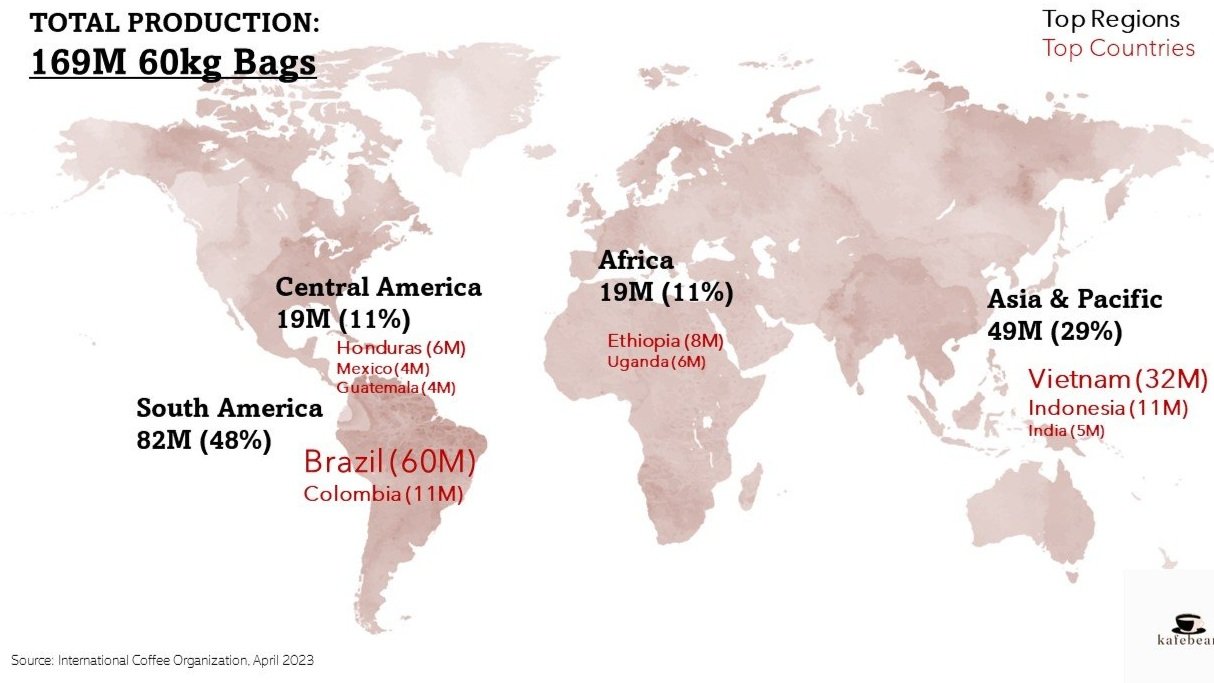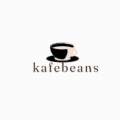
I am certain you must have wondered many times, what coffee beans do Starbucks use? Or what beans do Folgers use? In this article, we will explore what coffee beans are out there, the differences between various types, and help us understand the correlation between type, taste, price, availability, etc.
Let us start from the beginning.
Table of Contents
- How many types of coffee beans are there?
- How much coffee is grown each year?
- What makes Arabica so popular?
- Where are coffee beans grown?
- What beans do top US brands use?
How many types of coffee beans are there?
Basically, there are four main types of beans, Arabica, Robusta, Liberica, and Excelsa. Based on the types of beans, coffee tastes will differ. But, the process of harvesting roasting, grinding, and brewing will further affect the taste and aroma. Refer here to learn more about the chemistry and science of coffee making.
Arabica is by far the most popular coffee bean taking 55% of the share, followed by Robusta with 40%, followed by Liberica and then Excelsa.
Arabica:
- Scientific name: Coffea arabica
- Flavor: Mild, fruity, natural sweetness with hints of sugary or fruity flavors
- Caffeine: 1.2 to 1.5% by weight
- Region: South America (primarily grown in Brazil)
Robusta
- Scientific name: Coffea canephora
- Flavor: More bitter taste, woody, or even rubbery taste. The flavors are often described as earthy, nutty, or woody, with a hint of bitterness and less acidity.
- Caffeine: 2.2 to 2.7% by weight
- Region: Primarily grown in Southeast Asia (Vietnam)
Liberica
- Scientific name: Coffea liberica
- Flavor: Unique flavor, Woodiness, Smokiness, herbal or spicy notes and often described as bold
- Caffeine: 1.3% by weight
- Region: Originated in Liberia (Africa)
Excelsa
- Scientific name: Coffea liberica var. dewevrei (reclassified as a variety of liberica)
- Flavor: Sweet, fruity, tart quality but strong and dark.
- Caffeine: 0.9 to 1.3% by weight
- Region: Primarily grown in southeast Asia and India
How much coffee is grown each year?
- World coffee production is around 168 million bags (2022). In the coffee world, each bag is around 60 kilograms., which is around 10 million metric tons of coffee produced every year
- Arabica contributed to about 99 million bags in 2022 and Robusta about 72 million bags (2022)
- South America is a leader in coffee production, followed by Asia, Central America and Africa

What makes Arabica most popular?
There are many reasons why Arabica coffee beans are most famous, such as mild flavor, lower caffeine content, higher quality as they are cultivated in higher altitudes, and global distribution. However, I would say that the sweet mild fruity flavor makes it a great starter coffee.
Robusta coffee tends to have a more pronounced bitterness compared to Arabica beans. This bitterness is due to the higher concentration of chlorogenic acids. The flavor profile is more nutty and earthy, with higher caffeine content.
The flavor of Liberica coffee is often described as bold, unusual, and sometimes even polarizing. It has a strong woody, smoky flavor can can have hints of spices, herbs flavor. Uniqueness makes it a rarer bean in consumption
Excelsa coffee bean flavor profile is tart, and acidic, and has a unique aroma (combination of fruity, woody, and spicy notes). Its availability is further limited making it a rare bean to be used globally
In summary, flavor is the primary reason for Arabica’s popularity
Where are coffee beans usually grown?
South America is by far the largest producer of coffee taking around 50% of world production. Brazil itself is responsible for around 60M bags of coffee. This is primarily due to its favorable climate, geography, and expertise in coffee cultivation. The region offers ideal conditions for coffee plants, with tropical and subtropical climates, distinct wet and dry seasons, and diverse altitudes. The Andes Mountains provide high-altitude regions, contributing to the unique flavors of the beans.
The most popular beans in Brazil are the Arabica beans producing around 40M bags with Robusta next at around 20M bags.
The second most coffee-producing nation is Vietnam with 32M bags. Vietnam has emerged as a major coffee producer, largely due to its advantageous climate, government support, and investment in the coffee industry. The country’s Central Highlands region boasts the ideal conditions for coffee cultivation, featuring a tropical climate with well-defined wet and dry seasons.
This climate, combined with suitable altitudes, favors the growth of Robusta coffee, which thrives in lower altitudes and is less susceptible to diseases than Arabica coffee. Vietnam’s Robusta bean production is at an impressive 30M bags.
What coffee beans do most US coffee brands use?
Most of the US coffee shops like Starbucks, Dunkin Donuts, Pete’s Coffee, and your nearest coffee shop are all using Arabica beans.
Starbucks’ primary coffee offerings include Arabica beans from regions such as Latin America (Colombia, Brazil, Costa Rica), Africa (Ethiopia, Kenya), and Asia-Pacific. Starbucks proudly serves only Arabica beans, as they are perceived to be of higher quality and more expensive. https://www.starbucksathome.com/ca/en-ca/story/why-arabica-beans
Folgers classic roast is a very popular coffee blend of arabica and medium-roasted Robusta coffee beans
However, Robusta beans are popular in Asia and also in instant coffee. Many European nations also tend to use Robusta coffee beans due to their bitter and nutty flavors.
Coffee bars in the southern part of Italy tend to have more Robusta in their blend
Conclusion
In summary, four types of coffee beans differ primarily in their flavor profile and where they are produced. Arabica beans is the most popular beans produced and consumed globally (55%), followed by Robusta (40%). Brazil is the largest coffee producer in the world harvesting Arabica beans followed by Vietnam primarily producing Robusta beans. We here in North America consume primarily Arabica beans-based coffee (as all popular coffee shops source Arabica) due to its mild fruity flavor while Asia consumes more of the Robusta blend. As for Europeans, they go both ways!
